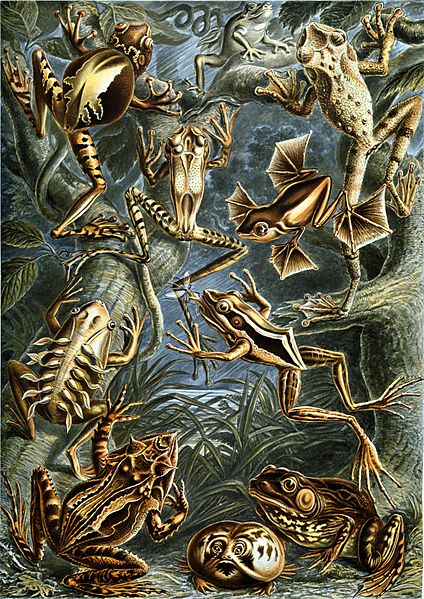Archivo: Haeckel Batrachia

Descripción: Notodelphys ovifera (Weinland) = Gastrotheca ovifera (Lichtenstein & Weinland, 1854) Hyla meridionalis (Boulenger) = Hyla meridionalis Boettger, 1874 Hyla tuberculosa (Boulenger) = Ecnomiohyla tuberculosa (Boulenger, 1882) Amphignathodon Güntheri (Boulenger) = Gastrotheca guentheri (Boulenger, 1882) Rhacophorus pardalis (Wallace) = Rhacophorus pardalis Günther, 1858 Hylodes lineatus (Schneider) = Lithodytes lineatus / Leptodactylus lineatus (Schneider, 1799) Limnodytes erythraeus (Duméril) = Hylarana erythraea (Schlegel, 1837) Ceratobatrachus Güntheri (Boulenger) = Ceratobatrachus guentheri Boulenger, 1884 Breviceps mossambicus (Peters) = Breviceps mossambicus Peters, 1854 Lithobates pipiens (Linné) = Rana pipiens (Schreber, 1782)Full text description (in German): English translation: [Remarks made by the translator are in italics or square brackets] Fig. 1. The pouch frog of Venezuela is remarkable for its female's possession of a paired dorsal [back] pouch, in which the eggs remain until the hatching of the tadpoles. A narrow triangular gap at the rear of the back (in the centre of the lightly coloured saddle patch) leads to the pouch. Fig. 2.Mediterranean Tree Frog, Stripeless Tree Frog The treefrog of North Africa and Southern Europe is little different from our native common green treefrog (Hyla arborea) and like the latter lives on trees and shrubs. When crying [calling], the male pushes forward the vocal sac like a bubble. Fig. 3. The treefrog of Ecuador is characterised by the crude build of its thick fingers (with very wide contact plates) and the knobbly skin, that like in toads is covered in glandular warts. Fig. 4. The climbing frog of Ecuador is among the slimmest and most supple forms of treefrogs; his extraordinarily thin and long limbs (with zebralike dark stripes across) enable it of the most dexterous climbing arts. Fig. 5. The flying frog of Borneo is remarkable above all other Batrachids for its extraordinarily widened foot webbings between the elongated toes. If the flying frog spreads these webs while jumping from tree to tree, he can use them as a parachute, similar to the flying dragon (Draconellus) among the reptiles (Plate 79) and the flying squirrels (Pteromys) among the rodents. Fig. 6. The military frog of Surinam is very peculiar in that the female carries its young on its back in military rank. The little tadpoles, numbering 12 to 20, attach to two diverging back ridges of the mother (that run symmetrically either side of the dorsal central line) by their oral suction plates. The mobile rudder tails are turned outward, on the left side as on the right. Fig. 7. The banded frog of Java has two parallel white bands on its back, running lengthwise, that contrast strongly against the dark red brown base colour. The jumping treefrog is about to capture an insect with its protruded bicornuated tongue. Fig. 8. The tip frog from the Solomon Islands is assigned to the group of "horn frogs" that are distinguished by a pair of sharp horns on top of the triangular head; these are elongated coverings of the upper eye lids. The bright colouration and patterning of this horn frog is most variable and often adapted to its environment. Fig. 9. The thickhead frog from East Africa (Mozambique, Sambesi) deviates from all other frogs in the appearance of its very short and thick head. Furthermore, it cannot jump with its short and weak legs, and moves its fat, crude body only with difficulty. The hind feet have large, spade-like digging swellings that help it to rapidly dig itself into the soil. It feeds on termites and in its subterranean habits is equal to the moles. Fig. 10. Northern Leopard Frog The piping frog of North America. Right behind the eye, one can see the large white, entirely superficially positioned eardrum.
Título: Haeckel Batrachia
Créditos: Kunstformen der Natur (1904), plate 68: Batrachia (see here, here and here)
Autor(a): Ernst Haeckel
Permiso: Public domainPublic domainfalsefalse Este material está en dominio público en los demás países donde el derecho de autor se extiende por 70 años (o menos) tras la muerte del autor. También debes incluir una etiqueta de dominio público de los Estados Unidos para indicar por qué esta obra está en el dominio público en los Estados Unidos. Tenga en cuenta que algunos países tienen términos de derechos de autor más de 70 años: México tiene 100 años, Jamaica tiene 95 años, Colombia tiene 80 años, y Guatemala y Samoa tienen 75 años. Esta imagen puede no estar en el dominio público en estos países, que además no aplican la regla de corto plazo. Otros como Costa de Marfil y Honduras tienen un derecho de autor general de 99 años y 75 años, respectivamente, pero sí aplican la regla de corto plazo. Esto está sujeto a la leyes respectivas sobre los derechos intelectuales. Esta obra ha sido identificada como libre de las restricciones conocidas en virtud del derecho de autor, incluyendo todos los derechos conexos. https://creativecommons.org/publicdomain/mark/1.0/PDMCreative Commons Public Domain Mark 1.0falsefalse
Términos de Uso: Dominio Público
Licencia: Dominio Público
¿Se exige la atribución?: No
Usos del archivo
La siguiente página enlaza a este archivo:

